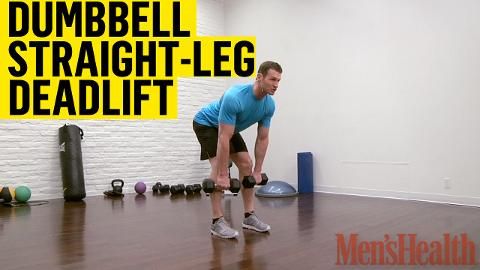One minute, you feel invincible: You’re squatting heavy, tossing bags of mulch, helping the lovely passenger in 12D hoist her bag into the overhead compartment. The next, your back barks, leaving you hunched over.
Researchers at the University of Sydney recently studied 1,000 patients to pinpoint some of the most common triggers of acute back pain—those sudden, sharp spasms that seemingly occur at any time and can leave you laid up for days.
Here’s how you can use their findings to stop hurting your back and keep yourself standing tall.
However, if your back does start aching, see your doctor if it lingers longer than 10 days or comes complete with shooting leg pains, which might indicate a more serious spine or nerve problem, says Jeremy Smith, M.D., an orthopedic spine surgeon at Hoag Orthopedic Institute in Orange, Calif.
Back breaker #1: Not paying attention
You’re 25 times as likely to hurt your back when you’re not fully focused on your posture during a manual task, the study found. This could mean a sudden interruption in the midst of physical labor—say, daydreaming mid-shovel.
But the problem doesn’t just apply to lifting tasks, says Stephen Chao, P.T., D.P.T., C.S.C.S., a physical therapist in New York City.
Slouching puts pressure on your spine and the surrounding tissues in a way that can ignite inflammation in your joints and spasms in your muscles (Check out the 5 Other Ways Sitting Can Screw with Your Health.)
Spine saver: Posture alerts
Stay focused on your alignment when lifting and just bumming around at your desk. Avoid slouching, rounding your low back, and sitting on your tailbone—a position called sacral sitting.
You may also want to consider using a low-back roll or lumbar support pillow to keep your back neutral and straight. You can also stick a Post-It to your computer or set phone or calendar reminders to check your posture every 45 minutes or so, Chao advises.
Back breaker #2: Awkward positioning
You’ll face 8 times the risk of back pain by assuming less-than-comfortable positions, the study showed. Think: kneeling down while gardening, leaning over a car engine, or even twisting in your desk chair to grab a file out of a cabinet.
Spine saver: Play it straight
Take whatever steps you can to face your task head on: Get up out of your chair to retrieve that TPS report, use long-handled gardening tools, or sit on a tall stool to position yourself closer to your work.
If your job function—say, auto mechanic or construction worker—makes it difficult to adjust your regular angle, ask your higher-ups about tools like ergonomic belts or engine lifts that can help relieve pressure on your spine, says orthopedic spine surgeon Praveen Kadimcherla, M.D., of Atlantic Spine Center in West Orange, New Jersey.
(Spend all day parked on your butt? This is The Exercise You Need to Do If You Sit All Day.)
Back breaker #3: Lifting heavy loads
Heaving hefty parcels or weights boosted the odds of back pain by 5 times, the study found.
When you increase the load, especially with moves like heavy squats and deadlifts, your spine often serves as the limiting factor.
“Lifting too much weight tends to result in flexion of the lower spine, which can not only cause back pain but possibly lead to bulging or herniated discs,” says BJ Gaddour, C.S.C.S., creator of Men’s Health StreamFIT and the Lose Your Spare Tire! exercise program.
Spine saver: Focus on form—and know your limits
Drop the weight by half or more and work on your form, Gaddour advises.
The goblet squat is also an effective exercise for learning how to squat with perfect form. Holding the weight in front of your chest enables you to sink straight down between your legs while keeping your chest upright.
Or move to single-leg work to shore up and balance your strength and mobility between sides of your body, Gaddour says. Exercises like stepups and single-leg hip thrusts also make it easier to keep your pelvis in a neutral position, which increases the stability of your back.
Back breaker #4: Attempting tasks far away from your body
Anytime you’re stretching—say, to get that corner of the ceiling with the paint roller—your risk for back pain may multiply by a factor of six, the study found. Reaching to hold that 5-pound bag of fertilizer at arm’s length takes more energy than holding it closer to you and actually puts 20 pounds of pressure on your spine, Dr. Kadimcherla says.
Spine saver: Move closer
This one’s simple: Just set up the task at hand so you can use your arms closer to the middle of your body, says Chao. Instead of reaching high overhead, use stepladders or extendable tools. (Duh.) Try the Mr. LongArm Tele-Roller ($13, homedepot.com) which locks out at an extra 2 to 4 feet.
Related: 17 Things Every Man Should Try
Back breaker #5: Hoisting an unbalanced weight
In the study, lifting loads that shift like unfolding ladders quintupled the risk of a back incident. A shovel filled with sliding snow or even a loaded-up messenger bag slung over just one shoulder can pose a problem too, Chao says.
As the weight pulls you to one side, your opposite hip, core, and shoulder muscles need to work overtime to keep your torso upright and stable, says Gaddour.
If those muscles aren’t strong enough to do that, your spine won’t be able to resist the twisting and turning forces, he explains.
Spine saver: Train Your Core
When you’re lifting a lopsided or unstable load like a catering tray or a suitcase, bring it as near to your body as possible. Ditch the satchel in favor of a two-strap backpack—or at least switch shoulders every 45 minutes or so, Chao advises.
And prep your body to handle asymmetrical loads with a mix of moves that train your core muscles to resist movement, Gaddour says. Think: plank variations or farmer’s carries.













